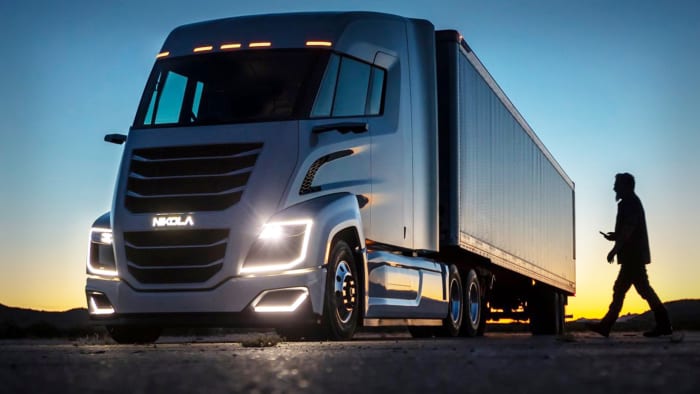The love at first sight between investors and young manufacturers of electric vehicles seems to have died.
As often in every relationship, the beginnings are marked by great promises. Everything seems beautiful, everything seems light. Few important questions are asked because there is hope that we have drawn the right number so that we close our eyes to things that would normally have alerted us to slow down.
We look forward to better tomorrows until something happens that derails the whole beautiful mechanism. We then open our eyes and we begin to ask questions we should have asked from the beginning.
This is somewhat the situation in which investors and Tesla’s (TSLA) – Get Tesla Inc Report rivals currently find themselves.
The time to ask the uncomfortable questions seems to have arrived.
Shares Battered on The Stock Market
With the exception of Lucid Group (LCID) – Get Lucid Group, Inc. Report, and Fisker Inc (FSR) – Get Fisker Inc Class A Report, the shares of most of these firms — Rivian (RIVN) – Get Rivian Automotive, Inc. Class A Report, Nikola (NKLA) – Get Nikola Corporation Report, Lordstown Motors (RIDE) – Get Lordstown Motors Corp. Class A Report, and Hyliion Holdings (HYLN) – Get Hyliion Holdings Corp. Class A Report — have crashed after surging. The prices of these stocks are now below their IPO price. And it is not certain that they will recover in the short term.
Most of these firms entered the market through a reverse merger with a special purpose acquisition company (SPAC). Typically, SPACs command an initial offering price of $10 — comprised of an equity unit and a warrant — with shares having the potential to move dramatically higher once sponsors reveal the merger target.
Rivian’s stock is currently trading at $47.37, down 39.2% from its November 10 IPO price of $78. In full euphoria, the action of the manufacturer of SUVs and electric pickups had risen to $172.01 on November 16, a week after its first stock market debut.
As for electric and hydrogen truck maker Nikola, its stock has lost at least 33.6% of its market value compared to its IPO price of $10.
Things are even worse for Lordstown Motors and Hyliion.
The Lordstown stock simply fell apart. From $10 when it debuted in October 2020, it is currently trading at $2.18, a drop of 78.2%. The stock market valuation has declined from $1.6 billion to $428.3 million last Friday at the close of trading. Basically, nearly $1.1 billion in market capitalization is gone in 17 months.
Lordstown Motors still hasn’t produced a single electric vehicle but the company continues to burn cash and needs it to solve its production problems.
Shares of hybrid and electric heavy-duty commercial truck firm Hyliion are currently trading at $3.77, down 62.3% from their IPO price.
Why Did Investors Fall in Love with These Startups?
Proponents of electric vehicle manufacturers like to say that these companies represent a promise, the promise of society’s transition to a zero-carbon world. Investing in these companies is, therefore, an investment in the future.
Therefore, we should not focus on their current income or lack of income. We must close our eyes to the money that these companies are burning and focus on the potential future income.
To further convince, they take the example of Google (GOOGL) – Get Alphabet Inc. Class A Report, Amazon (AMZN) – Get Amazon.com, Inc. Report, and Facebook (FB) – Get Meta Platforms Inc. Class A Report in their infancy. They admit it’s a very risky investment but the potential is too great to ignore.
Mordor Intelligence research suggests that the electric vehicle market is expected to be valued at $725 billion by 2026. Currently, the industry is worth $171 billion, pointing at a compelling CAGR of around 30%. In unit sales, EVs are projected to grow from around 2.5 million in 2020 to about 11 million in 2025. At those levels, electric vehicles would account for approximately 32% of the total market share for new car sales.
“The electric vehicle (EV) market is witnessing substantial growth owing to the swiftly escalating year-on-year adoption rate of electric vehicles across the world,” the research said. “For instance, there was a rise in electric vehicle sales dramatically in China and Europe, despite the pandemic showing signs of active market growth during the forecast period.”
Factors, such as the increasing cost of fuel and the government initiatives across different geographies to increase awareness about EVs, are expected to promote the usage of electric vehicles over the forecast period, according to the research.
“Infrastructure for charging stations continue to expand, and countries like China continue to lead the passenger vehicles and urban buses market owing to a well-established supply chain for batteries.”
What’s Wrong with These Young Actors?
It’s a bit like the wake-up call for most of these firms. There are some like Lordstown who have still not managed to build a single vehicle and have already pushed back the production start date several times.
At the same time, the company always needs money and there is no telling if it will ever deliver on its promises. We are still waiting for the famous Endurance EV pickup promised for several years now.
For other of these firms, they discover the harsh reality of ramp-ups and the bottlenecks that this causes. Investors want Nikola and Rivian to show that they can mass produce vehicles and sell them to customers.
Added to this was an image crisis for Rivian, a self-inflicted wound. Basically, Rivian decided overnight, without warning its customers, to increase the prices of its two models, the electric pickup R1T and the electric SUV R1S, both for customers who had already placed their order and for new customers.
Customers took this badly and the company recorded order cancellations. CEO RJ Scaringe was forced to publicly apologize.
“I have made a lot of mistakes since starting Rivian more than 12 years ago, but this one has been the most painful,” Scaringe wrote in a letter to customers.
“I am truly sorry and committed to rebuilding your trust.”



